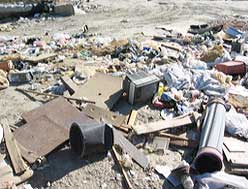Contact Pacific Southwest Waste Program
Pacific Southwest, Region 9
Serving: Arizona, California, Hawaii, Nevada, Pacific Islands, Tribal Nations
Solid Waste Management on Tribal Lands

Open Dump Cleanup on Tribal Land
On This Page:

Illegal dumpsite on tribal land in California

Sign to discourage illegal dumping
Open Dump Regulations
EPA defines an “open dump” as a multi-family dumpsite of any size or content.
The Resource Conservation and Recovery Act, Subtitle D, prohibits open dumping of solid waste.
For dumpsites posing an imminent and substantial endangerment, EPA can enforce closure under RCRA Section 7003 or RCRA Section 4005(c)(2). Citizens can bring federal civil suits under RCRA Section 7002 for potential or actual violations of RCRA.
Tribes can also develop codes and ordinances against open dumping and enforce them. For guidance on developing codes and ordinances, see “Developing Solid Waste Codes and Ordinances.”
Illegal Dumping Prevention and Enforcement
The Illegal Dumping Prevention Guidebook (PDF) (33 pp, 1.1M) guide gives tips for developing an illegal dumping prevention program, including information on site maintenance and controls, community outreach and involvement, targeted enforcement, and program measurement.
The Tribal Waste Journal – Respect our Resources: Prevent Illegal Dumping (PDF) (22 pp, 1.3M) guide has interviews with tribal leaders and tribal-specific tips for preventing illegal dumping.
Chapter 3 of the Decision-Maker’s Guide to Solid Waste Management (PDF) (14 pp, 610K) discusses how implementing and enforcing solid waste codes can be critical to preventing and prosecuting illegal dumping.
Coming soon – Illegal Dumping Enforcement Mechanisms on Tribal Lands
Currently in development, this guide will highlight creative and innovative dump enforcement mechanisms that have been used by tribes in Region 9.
Illegal Dumping Outreach and Education
- Kwis and Tiio in “The Dump”
 – Example of an educational cartoon from the St. Regis Mohawk Tribe.
– Example of an educational cartoon from the St. Regis Mohawk Tribe. - Tribal Decision-Makers Guide to Solid Waste Management – Chapter 6 (PDF) (14 pp, 526K)
Public Education and Community Outreach
Dump Assessment
Open Dump Survey
The Open Dump Survey Form (PDF) (Please SAVE TO YOUR COMPUTER and then fill out the saved form) (2 pp, 255K) and Guide (PDF) (14 pp, 76K) can help characterize an open dumpsite and develop risk-based prioritization for cleanups. EPA and Indian Health Services (IHS) also use this form to characterize sites. In order to have your tribal dumpsite listed on IHS's Open Dump List or on IHS's Sanitary Deficiency System List (SDS) (critical for being eligible for dump cleanup money under some grant programs); please send a completed form on each site to an EPA Tribal Solid Waste Team Member or contact your IHS area representative.
Indian Health Service (IHS) Sanitary Deficiency System (SDS) List
The Sanitation Tracking and Reporting System (wSTARS) is an inventory of the sanitation deficiencies of American Indian and Alaska Native communities, which consist of needed water, sewer and solid waste facilities for existing homes. The sanitation deficiencies data are identified by each of the 12 Indian Health Service Area Offices across the nation in consultation with the respective tribes in those Areas. The projects are scored based on several factors including health impact, cost, deficiency level, tribal priority, and O&M capacity. The list is used by Congress to fund projects. Recent historical funding levels for projects on the SDS list have been about $3.5M.
To see a current list of SDS projects:
- Go to the wSTARS web site.
- Click on the IHS area map or the region of interest.
- Click the "public access" link at the bottom of the page.
- Click the "one-line listing" link. The resultant list includes the projects in the SDS system. Project number, name (including in most cases the name of the tribe), priority, and cost are shown.
Tribal Example – Reno Sparks
The Reno-Sparks Indian Colony uses GIS to manage open dumping on tribal lands. Using GPS data collection methods in the field, the Solid Waste division has had success in gathering accurate in-the-field data on open dumping issues. Data collected in the field are managed in the office using GIS. The software has allowed the tribe to better organize, manage, and analyze their data in order to plan for the management of open dumps on tribal lands.
Illegal Dumping Economic Assessment (IDEA) Cost Estimating Model
The IDEA model, created by the Illegal Dumping Prevention Project, is an easy-to-use tool for assessing a variety of costs associated with illegal dumping activities, primarily in urban areas. Intended users include (1) state, tribal, and local government authorities and; (2) community groups and civic organizations. Specifically, the model can be used to: estimate the costs of cleanup activities; assess indirect costs; and conduct cost analyses.
GIS Software for Tribes (PDF) (23 pp, 4.0M) ![]()
Available through Environmental Systems Research Institute (ESRI) and BIA, this software can be used to map and catalogue open dumpsites.
Dump Cleanup
Funding Dump Cleanup
The Funding Opportunities Web page includes information on dump characterization and dump cleanup funding available from federal, state, and foundation grant programs.
Technical Advice for Cleanup
The Technical Advice for Cleanup Web site includes tips and samples for writing open dump cleanup, site remediation, health and safety, and public participation plans associated with the cleanup of open dumpsites on tribal land.
